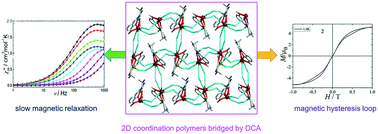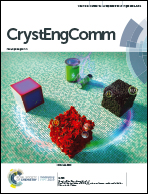Two-dimensional heterometallic CuIILnIII (Ln = Tb and Dy) coordination polymers bridged by dicyanamides showing slow magnetic relaxation behavior†
Abstract
Using dicyanamides, three two-dimensional coordination polymers (CPs) [CuII(valdmpn)LnIII(μ-1,5-dca)3]n (LnIII = Gd (1), Tb (2) and Dy (3)) were synthesized and characterized. Compounds 1–3 are two-dimensional coordination polymers bridged with μ-1,5-dca connecting the [CuII(valdmpn)LnIII]3+ units. In compounds 1–3, the Cu atom was pentacoordinated with an elongated square pyramidal (C4v) geometry, while the Ln (Gd, Tb and Dy) atom was nine-coordinated with a muffin (Cs) geometry. Detailed direct current (dc) magnetic measurements and simulated data demonstrated the existence of a ferromagnetic CuII–GdIII interaction for compound 1. Alternating current (ac) magnetic measurements revealed that compound 2 exhibited a slow magnetic relaxation behavior under a zero dc field. A hysteresis loop at 1.8 K was observed in compound 2, characteristic of typical single-molecule magnets (SMMs). However, compound 3 showed a slow magnetic relaxation behavior under a dc field. This system provides a good opportunity to determine the character of the Ln(III) ions incorporated and/or the origin of the slow magnetic relaxation behavior.



 Please wait while we load your content...
Please wait while we load your content...